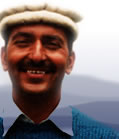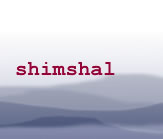 |
 |
||
 |
|||
|
RELATED THEMES communications traditional skills OTHER LOCAL THEMES BACKGROUND |
health Health is not a major topic in this collection, but there are some interesting descriptions of traditional treatments and several narrators also provide their views on Shimshalis' health and health care today as compared to the past. Traditional treatments include soups prepared from local ingredients and various topical applications for wounds. Gulshad also explains that: "Those [who] suffered from pain in the back, chest or ribs were treated by putting warm ashes in a piece of cloth and these were placed at the location of the pain. When the pain was elsewhere in the body, the patient was placed inside the fresh warm skin of a goat" (Pakistan 17). Religious and spiritual assistance was also sought at the time of illness. Many people went first to a mullah and asked for a tawiz (amulet) to treat the illness and one narrator says that a bitan (shaman; person who can communicate with the mountain spirits, enabling them to heal the sick or predict the future) might also be consulted. As in other collections a few narrators believe that people were healthier in the past and that today different diseases are prevalent. One of the reasons given is to do with diet: "…tea is not so good. It would be nice if we practiced our traditional moch (soup) instead of tea... The reason for good health [in former times] was that they would use moch in excess. The use of moch made their body strong and healthy" (Pakistan 5). However, several other narrators believe that, overall, health conditions have improved today due to the availability of modern treatments. One man says: "…the death rate has decreased compared to the past. Once, many people died of diarrhoea. It was so severe that everyday we would bury two or three dead bodies. It inflicted a heavy loss on the community. In another incident many people died of a throat infection. But today by the grace of Allah the birth rate dominates the death rate…" (Pakistan 10). Only one woman is asked for her thoughts on family planning. She feels positive about it and explains, "In former times… People would have as many children as they could but they were not worried about their conditions. But today it is a big deal to feed and educate the children… Therefore it is advisable to go for three children so that they are easily looked after and well educated. In this way the children also become valuable for the society and they also respect their parents" (Pakistan 17). Whilst there is a general concern about the road bringing more outsiders - and their diseases - to Shimshal, it will also relieve Shimshalis from the burden of having to carry the seriously ill out of Shimshal to a health centre or hospital in a larger town. In the past it would take a long time to carry people out of Shimshal for medical treatment and as a consequence many people didn't get treatment in time and died. quotes about health"As far as I remember, the soup of turnip, qeech (local medicinal plant) and yeenat (wild cherry) were used to cure the patients. Except this local treatment nothing was available to cure the patients… The diseases cured with these local medicines were kazik (typhoid), khala (back and chest pain) and for temperature." "[In former times]…if someone would fall ill then the patient would go to a mullah (any religious literate person who can recite words from the Holy Quran). The mullah would give him tawiz (amulet; traditional spiritual treatment for disease) to dissolve in water and to drink and also to inhale. Whatever it was it would alleviate the pain it was just our belief. When someone would suffer from chest and back pain he would drink the boiled water of qeech (local medicinal plant) and would chew the root of the plant. He would also apply the water to pain area of his body. This was our local treatment… the patient would recover from the local medicine but it would take time. Today I take the medicine and I recover quickly by the next day. But at that time it was not so quick and people would say that it is good to take time to recover…" "The patients of mirgi (Urdu for epilepsy) were normally cured with the help of tawiz (an amulet). The patient was also advised to inhale the smoke of sulphur. And he would recover because the disease was not of a severe nature but simply a mirgi. Another kind of treatment was to approach a bitan (shaman) and whatever he would suggest they would strictly follow it. So these were some of the treatments against the diseases… Today the medical science is quite advanced and the allopathic way of treatment is mainly used to combat diseases, because today we have access to the doctors and modern medicines are used for curing the diseases. Every child is thoroughly checked up at the time of birth and vaccinated against the diseases." "…by the grace of God the people in the past were so healthy and were spending a very long life, and they never felt ill like the people of today. Now life has become comfortable, but it has brought different diseases with it. "There is a lot of difference between the old times and today's society. In old times there were no doctors, hence diagnosis and treatment of diseases were made through traditional methods. Those who were literate would cure the diseases by tawiz (amulet). Even then, more people would die in those days as compared to the present time. People were ignorant about the nature of diseases… When people survived it was due to tawiz and duaa (prayers)… some diseases were cured with the help of local plants and flowers, but that was not so effective. The good thing was that, people would take moch instead of tea." "In old times I would use water from the open channel close to my house, but currently due to more pollution around the channels, we bring water from the spring… It is at about half an hours walking distance… Fetching water is a big problem. In our village we have a lot of problems regarding potable water. For this reason our women suffer with pneumonia because in winter they fetch water from the river… All these diseases to our women are caused by the use of steel water containers." "For wounds we used a special application of [the soft feather from a] dunglik (crane) and minderich (type of grass). Yes, these were medicine for wounds. Bitter apricots kernels were also used. [Either minderich or bitter apricot kernels were pasted on the wound and this was covered by the soft feather of a crane.]" |
|